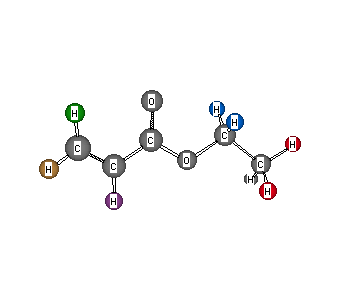Formula: C5H8O2
Answer: Ethyl acrylate
Chemical Shift Assignments:
1H NMR: δ 1.20 (t, 3H, J = 8 Hz), 4.18 (quartet, 2H, J = 8 Hz), 5.78 (d, 1H, J = 12 Hz), 6.09 (dd, 1H, J = 18 and 12 Hz), and 6.37 (d, 1H, J = 18 Hz)
13C NMR: 165.8, 130.1, 128.6, 60.2, and 13.8 ppm
The formula indicates two degrees of unsaturation. The signals at δ 1.20 and 4.18 in the 1H NMR spectrum comprise an ethyl pattern with an attachment to a heteroatom-- namely, oxygen. The remaining proton signals constitute an AMX pattern, and their chemical shifts (δ 5.78, 6.09, and 6.37 ) suggest that they are present as vinyl hydrogens. Thus, C2H5O- and CH2=CH- leave only C=O to separate these functionalities that are not coupled to one another. The chemical shift of the C=O carbon is typical of an ester. The hydrogen at δ 6.09 is upfield relative to the two other vinyl hydrogens because of deshielding due to resonance. This hydrogen is coupled by 18 Hz to the one at δ 6.37 (trans) and by 12 Hz to the one at δ 5.78. There is usually very small coupling between geminally substituted vinylic hydrogens. Return to Menu.
 |
oxygen-yellow |
|---|